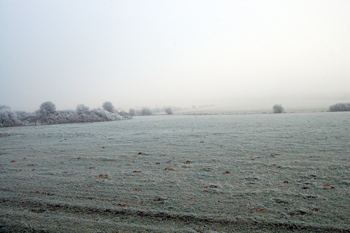![Pieces of mortaria from Shirrel Spring [X325/146/125]](/CommunityHistories/Totternhoe/TotternhoeImages/Pieces of mortaria from Shirrel Spring [X325-146-1.jpg)
Pieces of mortaria from Shirrel Spring [X325/146/125]
The Romans invaded Britain in 43AD during the reign of the Emperor Claudius (41-54AD). It took a number of years to subdue what is today England and Wales. The Romans eventually left Britain, according to the Anglo-Saxon Chronicle in 410AD (the Chronicle is made up of a number of different versions one of which says, for 410, "In this year the Goths stormed Rome and the Romans never afterwards reigned in Britain"). Totternhoe has a considerable number of finds and sites associated with Romano-British occupation. Roman finds in Totternhoe include both settlement sites and stray finds. The Bedfordshire Historic Environment Record is the basis for this article.
In 1899 a series of eight pits or trenches were uncovered in West Field, south of Castle Hill Road. The trenches contained Roman pottery, roof and floor tiles and animal bones and were interpreted as waste pits. West Field lies to the west of Totternhoe Roman villa (see below), which was excavated in the 1950s. In 2000 a cropmark indicating an arrangement of ditches was identified (on the 1996 air photos) in West Field, corresponding to the 1899 discoveries and to surface scatters of finds. It is probably the site of a farmstead, though its date relative to the villa is not known. Artefacts were reported in and around Shirrel Spring in 1920 [HER 26], including Neolithic flints, Roman pottery and coins, and a brooch dated to around AD700. the pottery included fragments of mortaria (vessels with roughened interiors for grinding) such as those shown at the head of this page [X325/146/125]. Further finds of Roman pottery and tile were made during field walking in the 1980s.
The site of a building, thought to be an Iron Age or Roman hut containing a hearth was found west of the school [HER 1410]. The site produced finds of antler, Roman tile and quern stone but also several flint flakes and a scraper, showing that there had been people on the site at various times over at least a thousand years. Nearby were two human skulls in poor condition. The date of investigation of the site is given in different sources as 1895 and 1899, and the number and types of finds also vary.

The site of the Roman Villa January 2010
Perhaps the most exciting find in Totternhoe was the villa discovered at Church Farm [HER 534]. The villa was built around a central courtyard and the site measured approx 68 metres by 73 metres. It was identified in the 1950s and partly excavated. The villa was occupied in the 4th century, and had a bath block, tessellated pavements and painted wall plaster. Towards the end of the century some rooms were deliberately demolished. Later alterations included the conversion of a suited of rooms into a barn. A quantity of 2nd century pottery found on the site indicates earlier occupation on the same site, or close by. A sherd of 5th century Saxon pottery was found in the debris of the villa, suggesting some activity in the area after the villa was abandoned. Nothing is visible above ground. A very full account of the villa and its excavation appears in Bedfordshire Archaeology Volume 20 (1992) by Les Matthews, Joan Schneider and Barry Horne.
A scatter of pottery east of Totternhoe church [HER 15830] was probably associated with this villa. Another site thought to be associated with the villa is an unrecorded Roman site south-east of Church Farm, identified by scatters of pot sherds and tile fragments [HER 15843].
Finally, a field walking survey to the west of Shirrell Spring and north-east of Knolls View was centred on the site of a known Iron Age and Roman site. The finds recovered from the site included a large amount of Romano-British pottery and tile with lesser amounts of Iron Age and Medieval pottery. The scatter took on a linear form and the ceramic finds were associated with small scatters of stones and slag, which suggests that the site may have had some form of industrial activity occurring on it [HER 16275].
Other Roman material from Totternhoe are stray finds and objects with no clear recorded archaeological context. Prominent Dunstable antiquarian Worthington George Smith had an extensive collection of Roman material from Totternhoe, which was later donated to Luton Museum by local historian J. Steele Elliott [HER 7090]. The collection included: a fragment of mosaic floor; two fragments of floor tiles; five fragments of roof tiles; four fragments of querns for grinding corn and a bronze winged phallus, with a suspension ring. Additionally, in 1860 Smith had purchased a Roman cremation urn from a Dunstable rag and bone man, who said that it came from Totternhoe Hill [HER 7091], again, it is now in Luton Museum.
Five sherds of Roman pottery, found about 1888 [HER 1371], their exact find spot being known. They are now in Luton Museum. A spread of Roman pottery sherds of 3rd to 4th century date was found in topsoil near a Bronze Age round barrow north of Middle End [HER 1957], but no trace of Roman occupation was found.
Three Roman coins have been found in Totternhoe. The oldest was a brass coin of the Emperor Vespasian (69-79AD) [HER 6817]. A sestertius (the largest base metal Roman denomination), was found and dated to the late 1st to early 2nd century [HER 16238] and a fourth century Roman coin was once found in the mortar of one of the church buildings [HER 1413]. The coin showed a wolf suckling the legendary twins Romulus (supposed founder of Rome) and his brother Remus. Such coins date to the end of the reign of Constantine the Great (330-337).